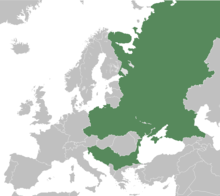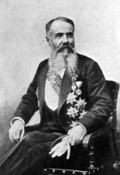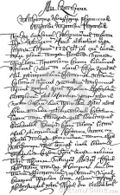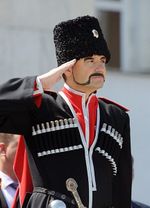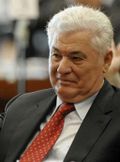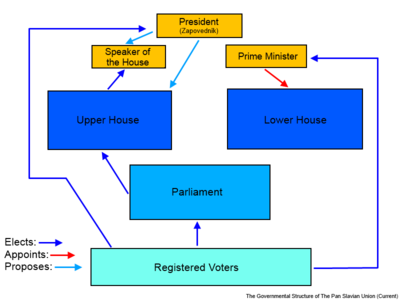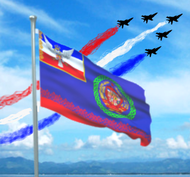Nation/The Pan Slavian Union
| This page is a work in progress by its author(s) and should not be considered final. |
Пан Славянска Cоюз
The Pan Slavian Union |
||||||
|---|---|---|---|---|---|---|
|
||||||
| Motto: "Едная Люда, Едная Сърца"
(Ednaya Lyuda, Ednaya Srtza) "One People, One Heart" |
||||||
| Anthem: "Hey Sloveni" | ||||||
The Pan Slavian Union in Europe (Green)
|
||||||
| Region | Slavia | |||||
| Capital | Slovenskograd | |||||
| Largest city | The Greater Slovenskograd District | |||||
| Official languages | Russian, Polish, Ukrainian, Belarussian, Serbo-Croatian, Bulgarian, Czech, Slovakian, Slovenian, and Macedonian. | |||||
| Recognised national languages | Russian, Polish, Ukrainian, Belarussian, Serbo-Croatian, Bulgarian, Czech, Slovakian, Slovenian, Macedonian, Romanian, and Hungarian. | |||||
| Ethnic groups | 92.5% Ethnicities of all Slavic nations 0.73% Hungarian 0.58% Romanian 0.47% Roma 0.35% Armenian, 0.15% Kazakh, 5.22% Other |
|||||
| Demonym | Pan-Slavian | |||||
| Government | Federal Republic | |||||
| - | President | Vlahadin Pravoslavljević | ||||
| - | Prime Minister | Previslov Chevonek | ||||
| - | Speaker of The Assembly | Vlashenik Barbakovchević | ||||
| Legislature | Head Council | |||||
| - | Upper house | Federativna Skupshtina (Federal Assembly) | ||||
| - | Lower house | Local Assembly | ||||
| History | ||||||
| - | Proposal | 1960 | ||||
| - | Beginning of Unification Talks | May 3, 1964 | ||||
| - | Establishment | March 15, 1967 | ||||
| - | West-Slavic Expansion | May 1, 1971 | ||||
| - | Re-Unification | June 2, 1982 | ||||
| Area | ||||||
| - | Total | 18,825,153 km2 7,268,432 sq mi |
||||
| - | Water (%) | 2.1% | ||||
| Population | ||||||
| - | March, 2012 estimate | 526 million | ||||
| GDP (PPP) | 2014 estimate | |||||
| - | Total | Дин. 12,252,162,162,900.00 ($21,599,674,277,867.80) | ||||
| - | Per capita | Дин. 1,154,756.64 ($35,959.16) | ||||
| GDP (nominal) | 2014 estimate | |||||
| - | Total | Дин. 115,256,735,271,262.00 ($3,589,098,971,483.89) | ||||
| - | Per capita | Дин. 788,780.06 ($24562.64) | ||||
| Gini (2012) | 28.7 low |
|||||
| HDI (2014) | 0.792 high |
|||||
| Currency | Pan-Slavian Dinars (Дин.) (PSD) |
|||||
| Time zone | Slavian Time (UTC+2/+5) | |||||
| Date format | mm*dd*yyyy | |||||
| Calling code | +381 | |||||
| ISO 3166 code | PSU | |||||
| Internet TLD | .psu, .pss, .пcc | |||||
The Pan-Slavian Union, officially the Federal Republic of The Pan Slavian Union (Neo-Slavic: Pan Slavyanska Soyuz, Cyrillic: Пан Славянска Cоюз, pronounced [pæn slɑːvjɛnskʰa sɔˌjuːz]), is a nation located in a multi-national reltations-based establishment called Slavia. Having founded this Region, it serves as one of its administrative nations. The country itself is composed of twelve republics which are subject to the Federal Government and Assembly (Federativna Skupshtina) seated in Slovenskograd, the capital. The Pan Slavian Union was formed on the basis of unification of all Slavic nations, whose peoples have proven to be very similar in many respects. The histories of its individual republics are respected and remembered throughout the nation, however an intense effort has been made throughout recent years to abandon past conflict between the fellow Slavic nations that make up this nation, in order to maintain order and unity.
The establishment of The Pan Slavian Union was inspired by proposals first drafted by Vuk Hrabrljević, a Serb politician and poet in Yugoslavia. The concept was overviewed by the Pan-Slavic Conference of January the 7th, 1964 (held in Prague, Czech Republic), and lead to the initiation of unification talks which concluded in May the 3rd 1964, resulting in the manifestation of the Proclamation of Unification all throughout Slavic countries in Europe. Finally, on May the 15th 1967, the establishment of the Union was approved by all parties involved. Years later, Poland, the Czech Republic, and Slovakia joined the Union as well, during the Western Expansion of 1971. The Union was modified to a Federal Republic on the second of June, 1982, when further intensifications of unity arised in the Union, demanding a more solid state.
Today, The Pan Slavian Union has refrained from joining the World Assembly due to the results of the referendum in 1996 which resulted in favour of not joining the Assembly. There have recently been talks initiated between The Pan Slavic Union and the World Assembly to re-submit an entry proposal to the Pan-Slavian people, but the process hasn't seemed to have gotten to a sizeable rate of progress following the effects of the Anti-WA protests held in Slovenskograd. Despite that, international trade and foreign investment has grown in the past few years due to more trade-friendly policies initiated by the Federativna Skupshtina in seated in the capital.
Contents
Etymology
The name "The Pan Slavian Union" has come to existence following a vote held in the Pan-Slavic Conference which favoured it by a percentage of 32% of voters, the second most popular proposal being "The Pan-Slovenskan Union" which recieved 22% of the votes. The prefix "Pan-" comes from Greek (πᾶν, pan, meaning "all", "of everything", "involving all members" of a group). In the name of the nation, the dash was removed in 1972 due to the preference of the Federativna Skupshtina - an action supported by the desire to make the official name uniform and writable in standard letters only. The term "Slavic" is used to describe the Pan-Ethnic group which mainly populates regions including Eastern Europe, Southeast Europe, Central Europe, and Russia. Slavic people share old traditional and cultural ties that extend considerably far back into ancient history. The term "Slav" does not have a clear origin, though several various theories exist.
History
The Pan Slavian Union was first proposed in 1960 by a Serb politician and poet by the name of Vuk Hrabrljević (his full, un-shortened name being "Vuk Petrobojomedrankovchelaković Hrabrljestojkopetromilislavljemitraljevskikrajishnikosrbinović). The original copie of the draft of what he titled as the Proglašenje Ujedinjenja (Proclamation of Unification) were put on public display in the Union Museum in Slovenskograd, and upon publishing, it was almost immediately spread throughout the Slavic world and caught the attention of people from all classes and aspects of society.
The Proclamation of Unification was brought forth in 1963 to Cheslav Mirovich, a Czech politician who in the following year, became President of the Pan-Slavic Conference. Mirovich in 1964 financially and publicly supported Hrabljević in publishing the Proclamation, which was the turning-point of Pan-Slavism in Europe. As spring came, interest in the idea of a unified Slavic state grew immensely, to the extent that talks were prepared to be organized in Bratislav, Prague, and Belgrade to emphasize and enbolden the strength and will with which Slavic peoples from all across Eastern Europe wanted to live under one state. The talks took place on May the 3rd, 1964, and resulted in the agreement to organize campaigns both locally and internationally to promote Pan-Slavism.In the three years between the initiation of Unification Talks and the Establishment of The Pan Slavian Union, the support for a unified Slavic state grew, and was especially concentrated in Russia, Poland, Belarus, the Czech Republic, Slovakia, and Serbia. Noticeable opposition came from critics in Croatia and Bulgaria, none of which resulted in significant damage to the seemingly exponentially growing desire to unify all Slavs. In 1967, the leaders of all Slavic nations (with the exception of Slovenia, whose President was visiting Austria at the time) met in Moscow to discuss the possibility of a Union being created.
It was rather confidentially agreed upon that the establishment of the Union was soon to take place, and the news about the unilateral agreement was released on February the 7th, 1967. In little over one month later - on March the 15th, the establishment of The Pan Slavian Union took place, and the signing of the Unification Documents took place on behalf of Russia, Ukraine, Poland, the Czech Republic, Slovakia, Serbia, Croatia, Montenegro, Bosnia and Herzegovina, Slovenia, Bulgaria, and Belarus. All republics joined the union at the same time, in accordance with the planned procedures set in the Unification Talks in 1964.
Conflicts concerning Religious differences have been sparse, with the exception of the Katowice protests of 2007 which were aimed at stopping alleged preference for Orthodox believers over Catholics in the nation-wide Pan-Slavian Economic Forum. The protests ceased after two days following the apology of Vladimir Pavlov, leader of the PSEF, for discrimination in the 2007 summit in July which consisted of the firing of a Polish member without suitable grounds. Several governmental and non-governmental organization have been created to re-inforce the unity between Catholics and Orthodox Christians in the PSU.
Culture
The culture of The Pan Slavian Union is exemplary of the abundance of influences and original richness that thrives in all Slavic nations. It however cannot be easily generalized and unified into one culture in and of itself due to the sheer variation and differences between the cultures of the individual republics. In 2001, Preslav Zatroeslov (a Bulgarian who served as the former Speaker of the Federativna Skupshtina) wrote an article in the Politiskaya (the nation's most popular newspaper at the time and in the present day) about the various Slavic cultures and their differences, establishing an identification of the three main Slavic sub-groups as culutral groups. It has proven realistic as the reality is that West Slavs, East Slavs, and South Slavs are groups that have more similarities within themselves than among eachother.
West Slavic Culture
The West Slavs have a fascinating culture that has evolved from the interactions and mixing of traditions, music, clothing, etc. between Poles, Czechs, Slovaks, Sorbs, and other West Slavic peoples over many centuries. Poles, Czechs, and Slovakians have played the largest roles in influencing and shaping West Slavic culture. Being Catholic peoples, West Slavs have been influenced by Western Europe to a great extent. However, they have held onto their Slavic traditions, which is displayed in their dances, clothing, folklore, and so forth.
East Slavic Culture
The East Slavs have been and still are very culturally close to the West Slavs, but are not the same in the sense that their traditional music and other cultural aspects are noticeably different than that of the West Slavs. East Slavs consist of Russians, Ukranians, Rusyns, Belarussians, and other sub-ethnicities of the four groups mentioned. Ukraine and Russia in specific are historically and culturally related to such an extent that one who is unfamiliar to Slavic culture and the culturese of the specific Slavic countries would very likely have difficulty differenciating between their traditional dances and traditional clothing styles. Belarus is the closest to West Slavs in culture and language, though is also very similar to Russia.
South Slavic Culture
The South Slavs have been influenced by a wide range of cultures and groups throughout centuries, and for some South Slavic groups, throughout millenia. Apart from Slavic influences (being the most prevalent), notable influences include Greek culture, Armenian culture, Thracian culture, Illyrian culture, Arabic culture, and Celtic culture. Hellenism and rule under the Ottoman Empire have brought more Oriental styles to the music, clothing, and traditions of the South Slavic peoples. Slovenia is somewhat of an exception to this, as by being deep under Austro-Hungarian rule during the Ottoman oppresive and savage conquest of the Balkans, it has maintained its Western European cultural resemblance which today makes the Slovenes seem more West Slavic than South Slavic in cultural terms. Islamic influences have costed Southeast Europe a significant amount of its heritage and identity, the results of which can be unfortunately somewhat identified in placed such as Bosnia and Herzegovina, and the Turkish-inhabited areas of Bulgaria. Modernism has mixed with the music of South Slavic nations and completely changed the clothing typically worn by South Slavs, but has not disrupted the richness and beauty that thrives in Southeast Europe.
Government
The Pan Slavian Union is a Federal Republic whose government is seated in the capital of the nation, Slovenskograd. The structure is similar to that of many other nations, and features a Legislature, a Lower House, an Upper House, and a Parliament. Each of the twelve republics of The Pan Slavian Union has its own seperate Lower and Upper Houses, thus each governmental house in the nation has its respective suffix describing what area it governs.
The current President of The Pan Slavian Union is Vlahadin Pravoslavljević, a Russo-Serb with some Polish ancestry. The election in which he ascended to his position was won by the Pan Slavian Progressive-Conservative Party, generally described as a future-minding, open-thinking, somewhat religious party that gained 52% of the total vote in the previous election (which took place in 2012). No coalitions have been made since 2008, and the political atmosphere has been relatively stable since the Free Media Act of 2007 was passed by the Upper House of The Pan Slavian Union. Pravoslavljević is an instrumental figure in the modernization of the country, yet he maintains his widely-known sense of centrism by claiming openly that "old traditions will never be forgotten". Changing his name in 2010 from Vladislav Pavlović, he sparked a trend in the country which consists of people generating and creating new names for themselves in addition to the traditional ones given conventionally (recognized by the government as Imenepravit, or Name-Making).
The Prime Minister has assumed office on the same day as the President, and is hailed by the populace of the PSU as the catalyst for improving the nation's international relations with not only its neighbours, but various countries from all over the world. Chevonek became friends with Pravoslavljević in 1998 when their political careers began as representatives in the Upper House of the Republic of Russia. The two political allies, despite having a great amount of trust and appreciation for eachother, do not seem to overpower the strong and healthy opposition in the Federal Upper and Lower Houses and national Parliament.
The structure of the Government of The Pan Slavian Union is one that has been reformed a total of 11 times. The basis of the structure lies in the aim to represent the populace as well as possible. The following diagram shows the structure of the Federal government. The individual governments of each republic are not shown, as they are exactly the same as that of the Federal Government, with the exception that the President of each republic is not referred to as the Zapovednik (a term given only to the President of The Pan Slavian Union).
The flag of The Pan Slavian Union has undergone a total of eight changes over the course of Pan-Slavian history. The reason for these changes were desires on the part of the Pan-Slavian public, not personal interests of any individual party. Since the nation represents twelve various peoples and republics in their own right, agreeing on a lasting flag has been somewhat of a challenge over the past few decades. The most recent and current flag however has caught more attention and acceptance throughout the Pan-Slavian populace than any previous one, and is believed to be a more permanent and reliable design that will not be challenged in the near future. All previous flags (including the current flag) have two things in common which is that they all have the Pan-Slavian tricolour as their background, and feature the Pan-Slavian Coat of Arms which represents a collection of the individual coat of arms of each of the twelve Slavic republics. The following is the flags in their respective order from oldest to newest, beginning from the first flag of the PSU proposed in the Unification Talks of 1964:
Defense
The defence capabilities of The Pan Slavian Union have always been remarkably high due to the unprecedented level of co-operation between the twelve republics that followed the Establishment of Unification in 1967. Since then, forces have been joined among the twelve republics and today form The Pan Slavian Army.


